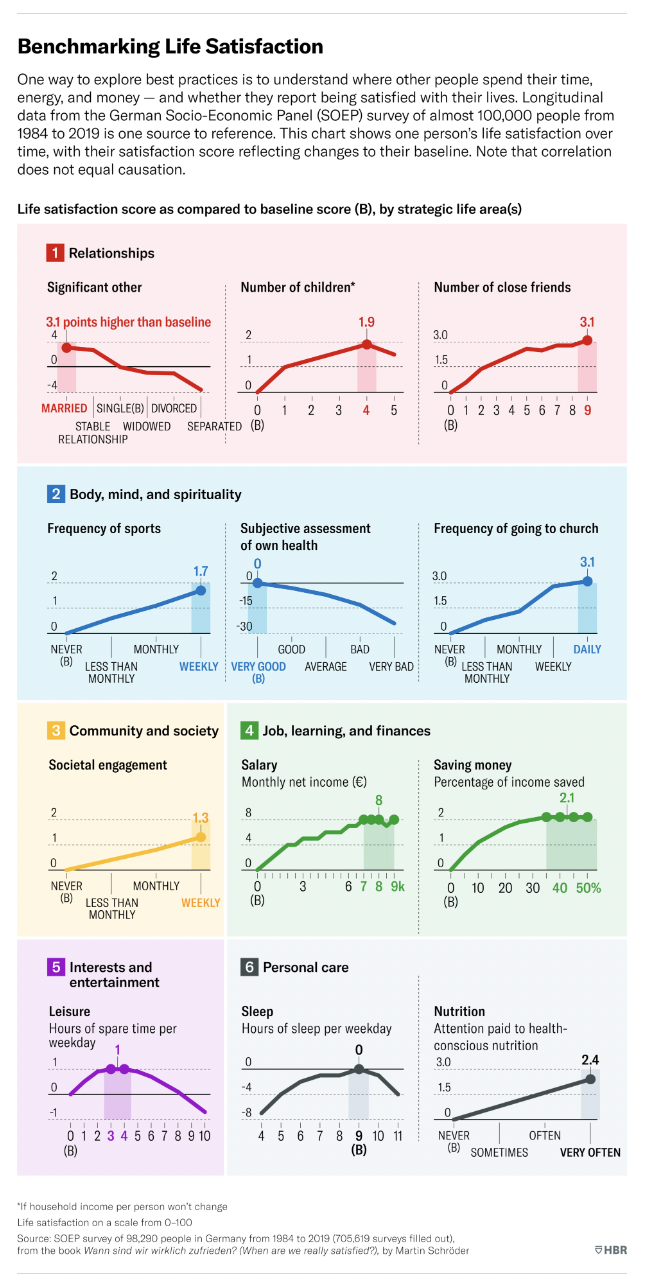Strategy and Science
10 Feb 2024Strategy Often Seems Complicated
Harvard Business Review recently published an interesting article exploring how business strategy principles can be used to enhance personal life.
However, the author’s lengthy 7-step process made it pretty impractical. Their approach seemed overly complicated and not specific enough to be easily actionable, typical of an academic perspective. Wasn’t able to finish the article, let alone apply it to my life.
And it seems like this is the default mode strategy is talked about in general. (Complicated, impractical and academic.)
But Does It Have To Be?
A more simple, but no less effective, approach could be to focus on the “Benchmarking” step highlighted in the article.

The overlooked gem here is the correlation between life satisfaction and measurable life aspects (like net income, number of friendships, etc.), effectively a mathematical model of life satisfaction. This allows for an objective assessment of life based on easily-quantified factors, as opposed to the subjective scoring suggested in the article.
By focusing on this model, I think the 7 ill-defined steps can be simplified into 3 clear actions to strategize your life improvement:
-
Survey Your Life: Conduct a multiple-choice survey on various areas of your life.
-
Benchmark Your Results: Use your survey results to estimate your Relative Life Satisfaction (RLS) in those areas, and compare those to the maximum possible RLS in each area.
-
Strategize: Identify areas with the most potential RLS gain. Develop a focused action plan to enhance the measurable factors.
Note: Check out this simple app designed to facilitate this 3-step process: https://strategize-life.streamlit.app/.
The “Diagnose-Guide-Act” Strategy Framework
A benchmarking-centric approach also aligns well with the framework Richard Rumelt describes in “Good Strategy/Bad Strategy”, comprising of three elements:
-
Diagnosis: Deeply understand the problem that you and/ or your organization are trying to solve.
-
Guiding Policy: Establish an overarching approach, leveraging strengths or competitive advantages.
-
Coherent Action: Implement practical, aligned actions to execute on this approach.
Rumelt emphasizes that the ‘diagnosis’ phase is the most difficult and often neglected, requiring hard choices about which problem to focus on, how to define it and a thorough analysis of its root causes.
Benchmarking: A Tool For Strategy
In general, benchmarking seems to offer a clear path to developing strategy by measuring key quantities, comparing them to standards and using that to diagnose challenges and identify opportunities. Akin to how physicians diagnose their patients by comparing labs or imaging to what you’d expect in a “normal” or healthy patient.
And if you accept a broad enough definition of benchmarking, you can even use it to identify guiding policies that are most effective at “moving the needle” for those problems. For example, doing small experiments on a diverse set of policies to test which ones work, before making bigger commitments or investments.
Same thing for action plans. You can devise hypotheses about the best actions to take, and then test them in small ways before carrying them out in big ways.
Strategy and Science
Overall, it seems like strategy can be simplified in general by using measurement of known quantities to diagnosis problems and validate hypotheses about approaches and actions.
And this idea isn’t novel; it underpins the Lean Startup movement, which advocates for a more scientific approach to innovation and entrepreneurship. Test hypotheses early, measure results of enhancements and iterate quickly. Don’t rely on business plans or anyone else’s assumptions about the market.
And this approach doesn’t seem to just apply to startups. In an increasingly digital/ online world, all companies want to understand how digital innovation can help them grow and win. Also seems broad enough that it can be applied to personal life.
In other words, injecting some science into your strategy may be the simplest, most effective path to gains in life and in your work.
Notes
Correlation vs Causation
One weakness with the above is that it mistakes correlation for causation. That is, just because a measure (e.g. number of relationships) correlates with an outcome (e.g. life satisfaction) doesn’t mean that measure directly impacts it.
True, but it’s also not a bad place to start. And here’s why:
Mistaking correlation for causation assumes A directly influences B: A -> B. But it could be that a latent variable C influences A and B: C -> A and C -> B. So changing A won’t change B.
However, for most things in life, I think we usually know a C (or a set of potential things that could be C) that we could change to affect or improve both A and B.
For example, if you know you’re weak at relationships ( A) and you know that good relationships correlate with life satisfaction (B) then you can probably think of a handful of things you could be doing to improve your social or relationship skills (C).
In reality, it could be that improving your social skills itself is what really increases your life satisfaction (C -> B). But does it really matter whether it was that skill improvement (C) or the better relationships (A) that improved your life? Either way, you’re more satisfied.
Operational Excellence vs Strategy
Another rebuttal to an emphasis on benchmarking and measurement in strategy development would be Micheal Porter’s take on strategy, where he argues that operational excellence (by benchmarking or other means) is not a substitute for strategic thinking.
Except that he also argues there are only 2 generic strategies in business: cost leadership and differientiation. And, for cost leadership, it seems like operational excellence should be at the heart of that generic strategy. Benchmarking against industry standard production costs seems like a key activity.
There is also an argument to be made (again, if you take benchmarking more broadly as measurement) that–as the business world becomes increasingly online, with all the experiments that can be run and data that can be generated–a more scientific approach to differientiation would also be a key and powerful activity.
More on this for another post.